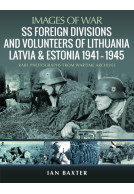Death Was Our Bedmate (Hardback)
155 (Lanarkshire Yeomanry) Field Regiment and the Japanese 1941-1945
Imprint: Pen & Sword Military
Pages: 208
ISBN: 9781781591697
Published: 27th March 2013
(click here for international delivery rates)
Order within the next 7 hours, 43 minutes to get your order processed the next working day!
Need a currency converter? Check XE.com for live rates
| Other formats available - Buy the Hardback and get the eBook for free! | Price |
|---|---|
| Death Was Our Bedmate eBook (17.7 MB) Add to Basket | £6.99 |
The book tells the story of a little known artillery regiment, the 155th (Lanarkshire Yeomanry) Field Regiment, RA which saw constant action during the ill-fated Malayan Campaign of 1941/42 and whose members later experienced the worst kind of hell as POWs of a cruel and bestial enemy.
Following the Japanese invasion of Malaya, the Regiment fought a brave and resolute rearguard action all the way down the Malayan Peninsular and onto the so called impregnable fortress of Singapore. Held in the highest respect by comrades and foe alike, this former territorial cavalry regiment fully deserved its Royal Artillery moto – Ubigue – 'everywhere'.
In the years that followed, the Gunners slaved, suffered an d died on the infamous Burma Railway, in copper mines of Formosa and camps throughout the Far East. More men of the Regiment died as POWs than fell in action. They should not be forgotten.
Included is a full nominal roll which allows the reader to identify the camp/s where each individual Gunner was held. A Roll of Honour provides the date, place and cause of death and place of burial/commemoration of the Regiment's casualties.
This is a very good read, although concentrating on the 155th Field Regiment, it tells the story of the camps and holds ones interest till the last page.
fepow-community.org
As mentioned in
Cumbernauld News
“The book details the events of the Japanese invasion of Malaya”
Retired Police Officers’ Association
“I found the book an inspirational and humbling read.”
Death Was Our Bedmate was not only an inspirational read but an imprtant and long overdue tribute to the officers and men of a little known regiment,the 155th[ Lanarkshire Yeomanry] Field Regiment RA. I found the book an inspirational and humble read.
RPOAS News- the magazine of the Retired Police Officers' Association Scotland
This is an excellent piece of research and places a unit in its complete context.
Society of Friends of the National Army Museum
Tells the story of the 155th Field Regiment, RA which saw constant action during the ill-fated Malayan campaign of 1941/42 and whose members later experienced the worst kind of hell as POWs of a cruel and bestial enemy.
Forces Pension Society
Anyone with an interest in history and in particular the South East Asian conflict will find this a remarkable, poignantly moving story. A unique book, being the only history of 155 Field Regiment RA. A fascinating regimental history based on the survivors' recollection of war. Captures graphically the chaos of war. Strongly recommend.
The Journal of the Royal Artillery
Included is a full nominal roll which allows the reader to identify the camp/s where each individual Gunner was held.
Britain at War
Death Was Our Bedmate is an inspiring read and an overdue tribute to the fallers and survivors during the regiment's horrific ordeal.
COFEPOW
A gem for military historians and enthusiasts alike, this book is a tribute to the fallen and survivors of the Second World War. It recounts the story of the ill-fated 155th Field Regiment, who, after the disastrous Malayan Campaign of 1941/42, were held hostage as POWs in unbelievably cruel conditions, suffering horrendously working on the Burma Railway, in the Kinkaseki copper mine and in camps throughout the Far East. In fact, more men died as prisoners then fell in action.
Scottish Field
A worn and battered, but still beautiful, nine inch crucifix stands proudly in a museum in Kanchanaburi in Thailand, testament to the courage and faith of a Dumfries former prisoner of war.
Dumfries and Galloway Standard
In 1939, on the outbreak of war, 19 year old Pat Campbell left his job as a trainee solicitor with Dumfries Town Council and joined other young local men in the ranks of D (Dumfries) squadron of the Lanarkshire Yeomanry. Later in the ill-fated Malayan Campaign of 1941/42, Pat's regiment fought bravely against a better equipped and experienced Japanese army and, following the fall of Singapore in February 1942, were taken prisoner. For the first few months of captivity, Pat and the others were made to work in warehouses, spread along the length of Singapore harbour, where the young former lawyer learned to steal with the best of them.
Half-starved, the POWs were forever on the lookout for small items that could be pilfered from the captured "booty" that they were loading on ships bound for Japan and which they later exchanged for food. Everything had a value and for Pat and the others the Seventh Commandment was pushed to the side with the encouragement of a New Zealand priest, Father Gerard Bourke, whose approach was that stealing from the enemy was fair game. Father Bourke held services in the run down POW camp where the crucifix was fixed to an old table. It was a place of refuge and peace for Pat during violent and cruel times - until he and hundreds of others from the Lanarkshire Yeomanry were sent to Thailand to labour on the infamous Death Railway.
Some time later, while slaving in that terrible place, he met up again with Father Bourke who was himself put to work building the railway. On one occasion Father Bourke, on being harangued by an angry drunken Japanese officer for not complying with an order "from the Emperor", bravely replied that he was unanswerable to a higher authority. When the puzzled officer asked who this was, the brave priest pointed heavenwards. Realising what he meant, the enraged Jap drew his samurai sword and raised it above his head with the intent of beheading the priest. Fortunately, an Australian army Doctor rushed forward and hurriedly explained: "Kistean churches very eccentric men," this explanation was accepted by the officer as evidence of excusable madness and so Father Bourke's life was saved. When Pat was moved on to another part of the railway, he was given the crucifix to look after as the priest was certain that his days were numbered.
Pat was one of the lucky ones who survived the horror of the Japanese death camps and made it back home. Of the 114 men of the regiment who died in the Far East, 90 died as POW's. All Pat had when he was released from captivity was a loincloth, a battered tin plate and a bamboo mug, his prayer book and the crucifix.
Last year when attending a reunion of veterans Pat took the crucifix from in his Dumfries home, still wrapped in the ragged bag he had used while a prisoner.
Now tarnished with age, its beauty still shown through and when the Lanarkshire Yeomanry Group told its story on the internet, within minutes an inquiry was received from the Thailand Burma Railway Museum in Kanchanaburi run by Australian Rod Beattie. The museum, considered the foremost authority on the story of the Death Railway, asked if they could borrow the crucifix for a display. Patagreed and it now stands proudly in the museum, testament to the faith, courage and determination of many brave men. Located alongside the museum is the Kanchanaburi War Cemetery where young men of the Lanarkshire Yeomanry lie buried.
Pat died a few months ago at the age of 92 years, but his story, and that of the others, has now been told in the recently released book, Death Was Our Bedmate (From a comment made by one of the POW's) written by Agnes McEwan and Campbell Thomson.
Speaking of Pat and the others; Campbell said: "They were special men who endured unspeakable cruelty far from their homeland. Many still lie buried in cemetries in the Far East. They should not be forgotten."
The story of a Scots soldier who was shot, bombed twice and survived one of the bloodiest massacres during World War II has finally been told. Known as the Gunner With Nine Lives. Lance Bombardier Dick Gwillim’s wartime memories have remained a secret until now. But a book, Death Was Our Bedmate, reveals tales of bravery and despair as soldiers like Dick returned home from war in the Far East.
Daily Record
This is a fascinating book guaranteed to enthral and repel its reader. What happened to the men of the 155th (Lanarkshire Yeomanry) Field Regiment in the war in the Far East is enthralling and deserves to be better known. The regiment’s efforts in the Malayan Peninsula as they fought overwhelming odds without help from Allied naval or air reinforcement are truly heroic. Their treatment at the hands of the Japanese is what the reader may find repellent.
Christine Warren, Carluke History.co.uk
Singapore finally fell early in 1942. The men’s subsequent treatment as Japanese POWs until 1945 is the stuff of films, but the watcher of a film can reassure himself that the on-screen barbarity is pretend. The brutality inflicted on the men of the 155th as they laboured to build roads, bridges and railways in Burma or mined in the hellish copper mines of Formosa is real and made even more real by the personal memories woven into the book. The reader is left in awe that any of the men of the 155th (Lanarkshire Yeomanry) Field Regiment survived to relate such memories.
The authors have extensively researched written sources but it is their use of oral history which makes this book so enthralling. It is a story, which once read, will not be forgotten.
Members of a doomed Scots regiment branded cowards after their harrowing Second World War ordeal have finally received recognition for their heroism.
Herald Scotland
Solders from Lanarkshire Yeomanry 155 Field Regiment were forced to surrender after the carnage of the battle of Singapore in 1942.
Their fate was to become slaves in Far East death camps working in “the depths of hell” amid untold pain and suffering. They endured daily torture and beatings and outbreaks of deadly diseases like cholera. However, after they were liberated in 1945, they returned home to a reception of hostility and shame because of their surrender. Now their story has been told for the first time in a new book written by retired police officer Campbell Thomson and Agnes McEwan.
Two Lanarkshire friends have written a book about the ordeal of a Lanarkshire soldier in a Japanese prisoner of war camp during WW2. Campbell explained: “John McEwan was the catalyst being the writing of ‘Death Was Our Bedmate’. About a year after I met him he was diagnosed with an incurable cancer and on the occasion I would talk to him about the old haunts which he had known as a young gunner in the Lanarkshire Yeomanry. He would comment sadly on the fact that little was known about what he and others had endured in the Far East. We traced the survivors who were still alive and recorded their stories. To a man they wanted the brutal facts of what happened to them to be revealed.
Hamilton Advertiser
They became slaves of the Japanese, working in the ‘depths of hell’ amid untold pain and suffering.
Daily Mail, Saturday 6 April 2013, Darren Hamilton
The men of the Lanarkshire Yeomanry, 155 Field Regiment were forced to surrender after the carnage of the battle for Singapore in 1942 then endured almost daily beatings and the constant threat of death.
But despite their ordeal, soldiers from the regiment returned home to hostility because of the apparent shame of their surrender. Now a new book aims to right the wrongs of their treatment – recognising them for the heroes they were.
Their story has been told for the first time in a new book by retired police officer Campbell Thomson and Agnes McEwan, daughter of the late gunner John McEwan.
One of the last remaining survivors, Tom McKie, now 93, told of the “Hell out of nowhere’ endured by the prisoners. Yesterday, Mr Thomson, 65, of Newmains, Lanarkshire, said: ‘Before John McEwan died, I drove him around Lanarkshire and he would sadly reflect that little was known of the regiment and what he and the others suffered at the hands of the Japanese. John died soon afterwards and a determination grew that the story of the forgotten men of the 155th should be told.
‘More men of the regiment died as prisoners of war than in action. These men were tremendously brave individuals who were subsequently treated as cowards and quickly forgotten.’
After their surrender, 250 men from the Lanarkshire Yeomanry were transported from Singapore on the England Maru, otherwise known as ‘the Hell ship’.
Most of the prisoners, including Mr McEwan, ended up working in the Kinkaseki copper mine in Taiwan. Mr Thomson said: ‘they worked naked most of the time apart from a pair of boots and a cardboard helmet. John described it as “the depths of Hell”. Many men died there’.
Those left behind in Singapore ended up working on ‘the Railway of Death’ in Thailand. Mr McKie, who worked on the railway, told how cholera killed many within hours as the Japanese provided no medical help.
Mr McKie, originally from Thornhill, Dumfries, recalled: ‘I would describe it as “Hell out of nowhere” – you never knew you were going to get tortured. You could be working away quietly and then you would be getting walloped with bamboo, or some other treatment depending on what you were supposed to have done or said.
“They used to take lit cigarettes and burn the back of your hands with them – I still have the marks on my hands. To get by, you had to put your mind to it and gave the attitude, “I’m not going to go home.”
‘A lot of the lads weren’t so lucky. Some of them gave up – the torture they were given more or less put them away. It was drummed into us not to talk about it by officers on the ship back home. I don’t know if they were sent on the ship to do just that.
‘It was bad enough being told what to do by the Japanese but it was shocking for our own people to tell us to not talk about it. I’m glad the stories are being told now I was one of the fortunate ones.’
Of the 114 Lanarkshire Yeomanry men who lost their lives in the Far East, 91 died as PoWs.
Mr McEwan and the other PoWs in Taiwan were moved from the Kinkaseki copper mine to a mountain camp in Kukutsu which, unbeknown to them, was intended as a place of extermination. While researching the book, Mr Thomson and Miss McEwan uncovered a Japanese, document titled Order to Kill, part of which reads: ‘However it is done, with mass bombing, poisonous smoke, poison, drowning, decapitation or what, it is the aim not to allow the escape of a single one, to annihilate them all, and not to lave any traces.’
The survivors were saved by the dropping of atomic bombers on Japan in August 1945, but were given no help back home.
Following the surrender of Japan after the attacks on Hiroshima and Nagasaki, the war in the pacific finally came to an end and prisoners of war who had suffered so much were finally liberated.
Wishaw Press
Te American Marines who arrived on Formosa, modern Taiwan, wept openly at the site of the scarecrow figures who tottered towards them. One of them was Motherwell man John McEwan.
Ages 24, he had endured over three years of slavery since being captured with his mates at the fall of Singapore in February 1942.
And now the story of those men in being told in Death Was Our Bed-Mate: the 155th (Lanarkshire Yeomanry) Field Regiment and the Japanese 1941-45.
Co-author Campbell Thomas, who wrote the book with John’s daughter Agnes, said “in the years following the Second World War, the veterans of the Lanarkshire Yeomanry, many from the Wishaw area, became the county’s forgotten heroes. Despite their valour during the ill fated Malayan Campaign of 1941-42, they were forever consigned to history as the men who had surrendered at Singapore.
“Little was known of the suffering they had endured as prisoners of the Japanese and it is only now, with the publication of the book that the full story of those amazing men has been told.”
About Agnes McEwan
Agnes McEwan was born in Lanarkshire in the years following the Second World War, the daughter of a former Gunner with the 155th (Lanarkshire Yeomanry) Field Regiment, RA, John McEwan, who survived three and a half years as a POW of the Japanese. His acclaimed account Out of the Depths of Hell was first published by Pen and Sword in 1999 and is now in paperback.
About Campbell Thomson
Campbell Thomson is a retired senior police officer (Superintendent) who initially joined the local Lanarkshire Constabulary. Despite sharing the same cap badge of the Lanarkshire Yeomanry, he had no previous knowledge of this local Regiment until he read John McEwan’s book. This led to a close friendship with McEwan and a determination that the sacrifice made by the men of this little known Regiment should be told.















